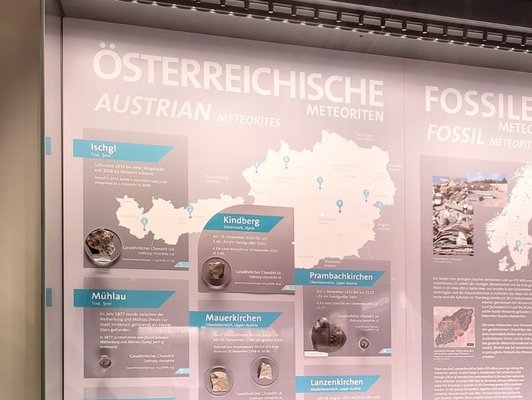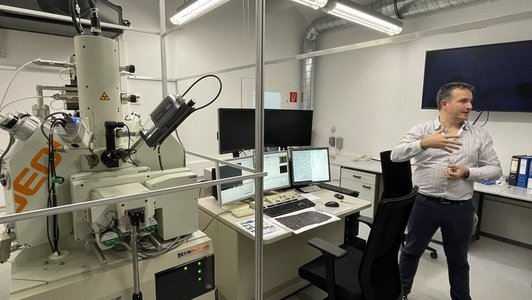

As there is a longstanding cooperation between the Natural History Museum Vienna (NHMW) and the OeAD, Dr. Ludovic Ferrière invited a few programme officers on a guided tour through the meteorite and impactite (i.e., rock formed during an impact of an asteroid or a comet) collections of the museum, so they could have a first-hand impression on the work he does. Dr. Ferrière, who has been working at the museum for more than 11 years, is mainly searching impact craters (i.e., crater structures, more or less eroded, which can be up to several kilometers in diameter and that were formed during huge collisions of asteroids with our planet Earth) and also extraterrestrial rocks that have safely landed on Earth, meteorites! He frequently travels to (remote) places where there has been an impact to find rocks or meteorites for his research, thereby making use of the funding available for S&T Cooperation projects (Scientific and Technological Cooperation) at OeAD. Through this funding, Dr. Ferrière and his partner at the Université Paris Cité (Institut de Physique du Globe de Paris) have been granted funding for the project “Probing the history and properties of meteorites using radon emanation”. This project will strongly contribute to decipher the radon release from meteorite samples and increase the understanding of the trapping and losses of gases from extraterrestrial materials.
In his office at the NHMW, Dr. Ferrière has numerous rock samples that he curates. Special sections, thin slices, and small pieces of these rocks can be sent to students and to established scientists worldwide to work on them in the laboratory. Some of the samples have been in the museum’s collection for many many years, some of them were collected by himself during his research trips, and others were generously donated to the museum, thanks to his efforts of securing them for the collection.
A guided tour in the Meteorite Hall, the largest meteorite display in the world, allowed us to discover an incredible number of meteorites, including one of the highlights, a piece of Mars that fell in 2011 in Morocco and that was acquired for almost half a million euros, thanks to the inheritance from Oskar Ermann. Another highlight is the three specimens of the Moon, collected during Apollo 15 and 17 missions, on permanent loan from NASA, which are presented together with meteorites from the Moon in a dedicated showcase.
During the tour, we also learned that eight meteorites were found in Austria, the last one very recently, the meteorite of Kindberg, a fall from November 19th, 2020, found by a “citizen scientist” after a search campaign that was initiated by Dr. Ferrière. When a meteor is seen (you can report here) by a large number of persons and filmed by video cameras, with possible meteorites expected on the ground, Dr. Ferrière usually goes on site to give out flyers to the public with instructions on what to do in case they find an unusual stone. Through this method, he receives emails with pictures of a variety of stones on a daily basis. In case of a meteorite, he can spot it instantly. Not so long ago he was lucky and received a picture of an obvious meteorite, found about eight months after it fell on the ground, the Kindberg meteorite, now on display at the Museum.
Dr. Ferrière’s enthusiasm for his research field is palpable and infectious. Should you find any peculiar stones, be sure to inspect them more thoroughly in the future, you may have found a meteorite, even though the chance is very very low. If you want to learn more about Dr. Ferrière’s research, you can find out more here or visit the Meteorite Hall at the NHM.
About S&T Cooperation: The international Scientific & Technological Cooperation programmes are based on intergovernmental and bilateral agreements or memoranda of understanding to fund bilateral research projects. On the Austrian side, the Austrian Federal Ministry of Education, Science and Research is funding travel and accommodation costs of researchers as well as project-related material costs of up to 2.000 EUR per project for a two-year project period. Current calls are open for Bulgaria and Ukraine.





